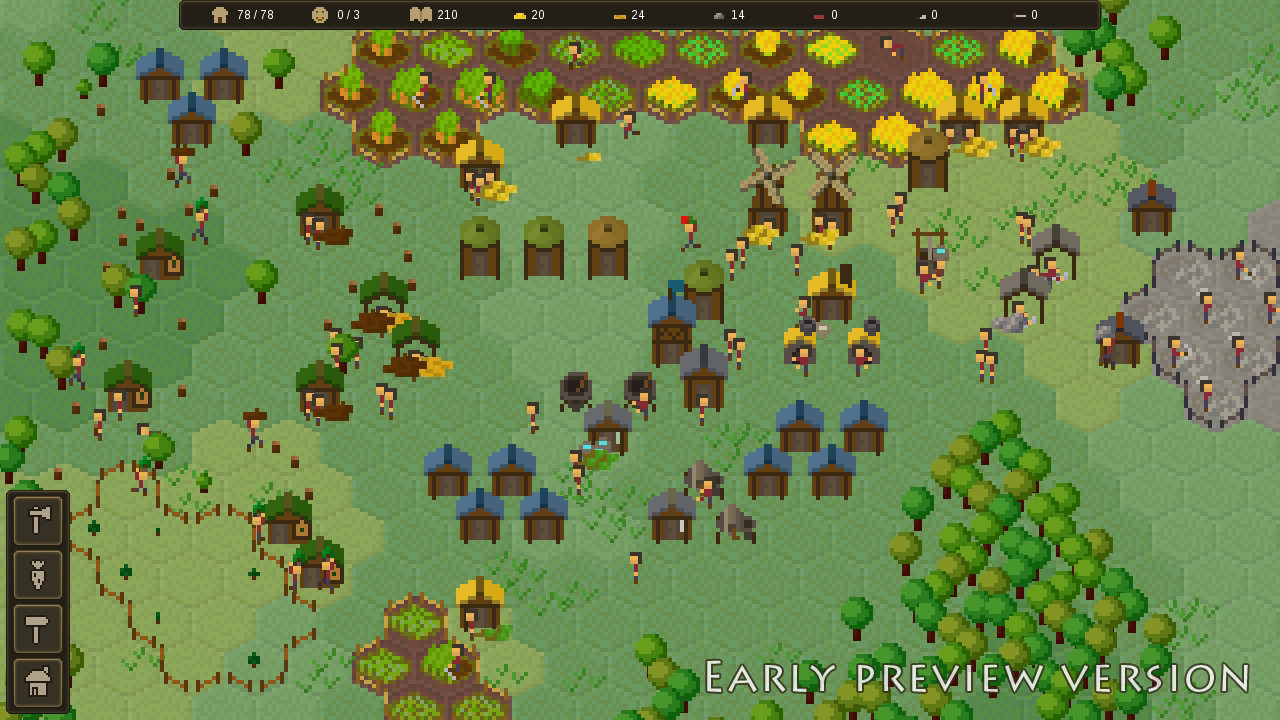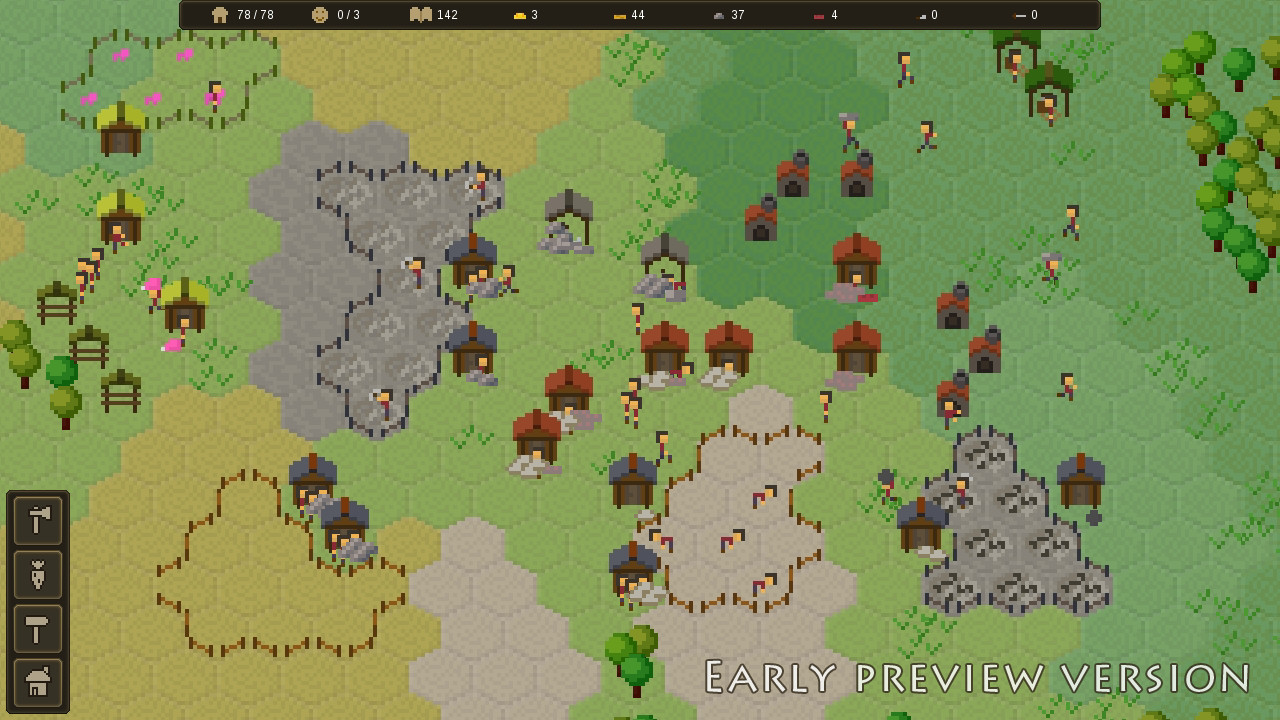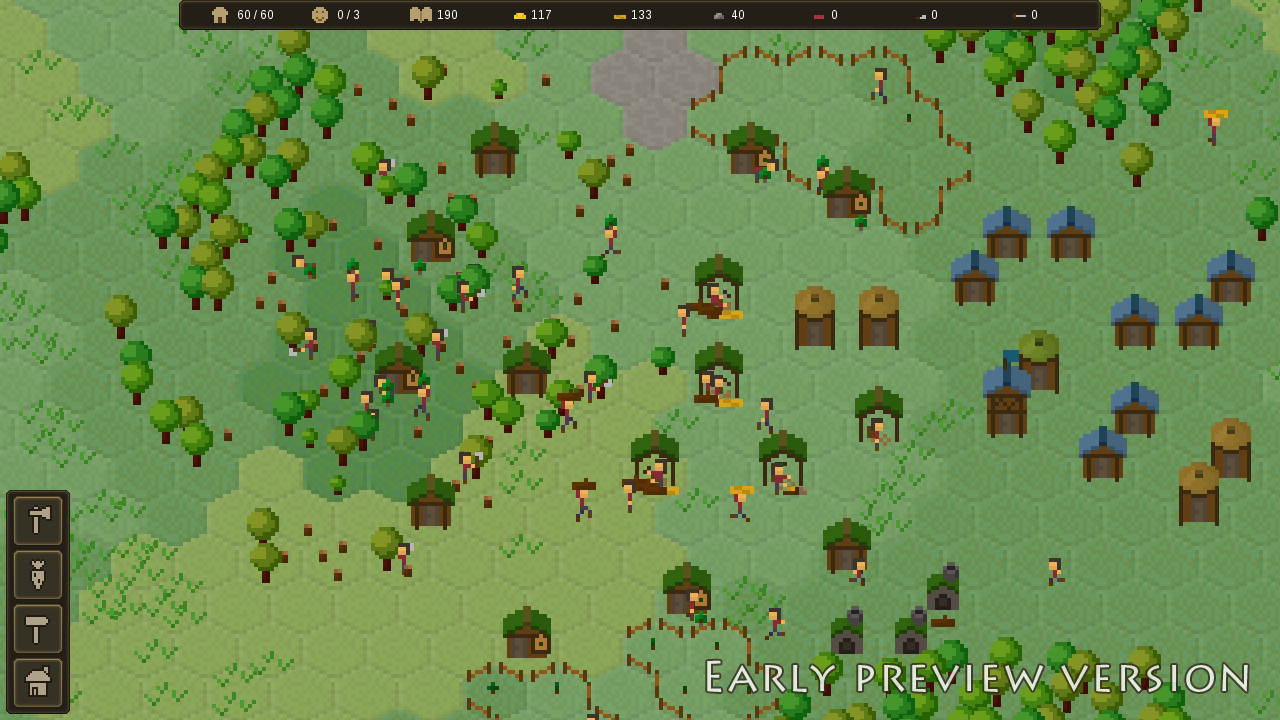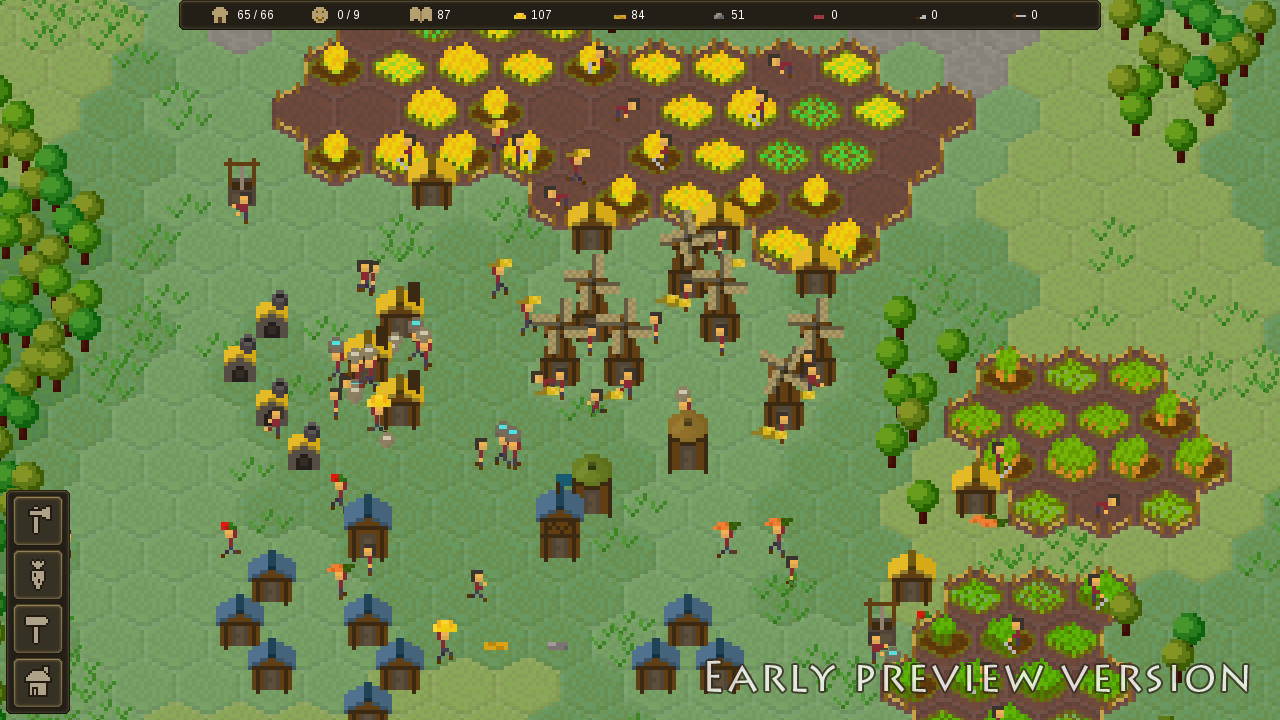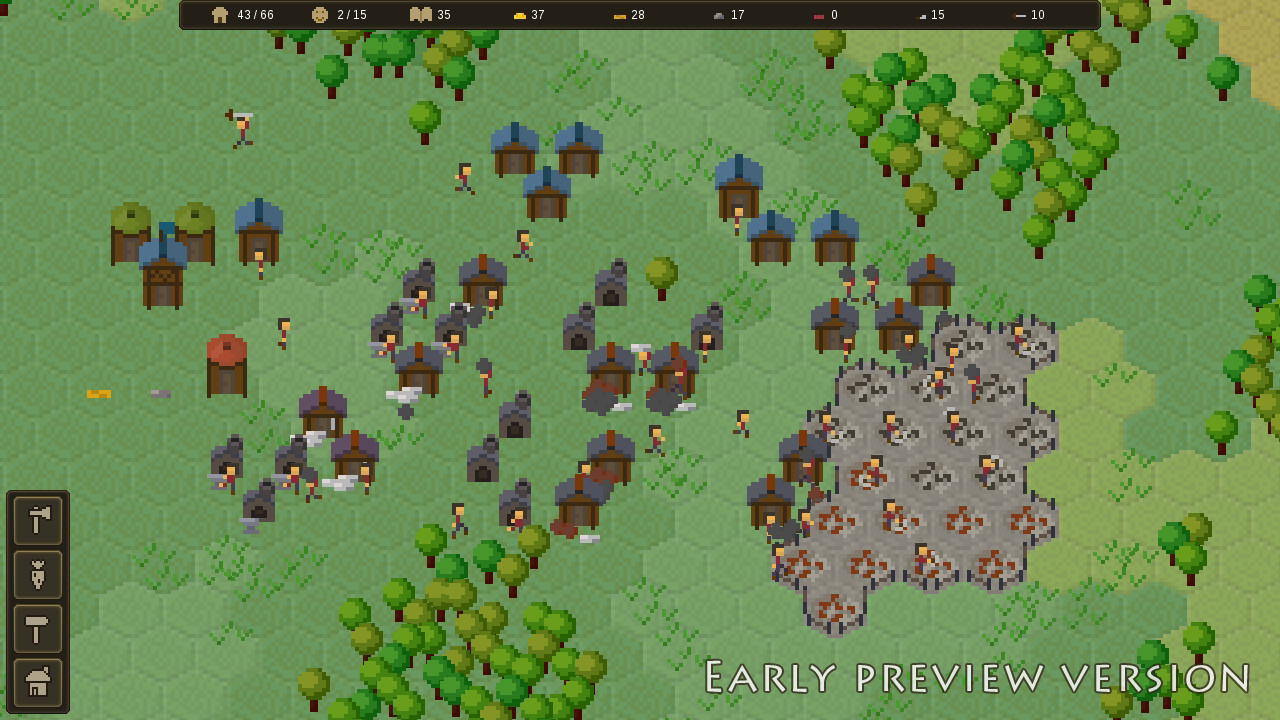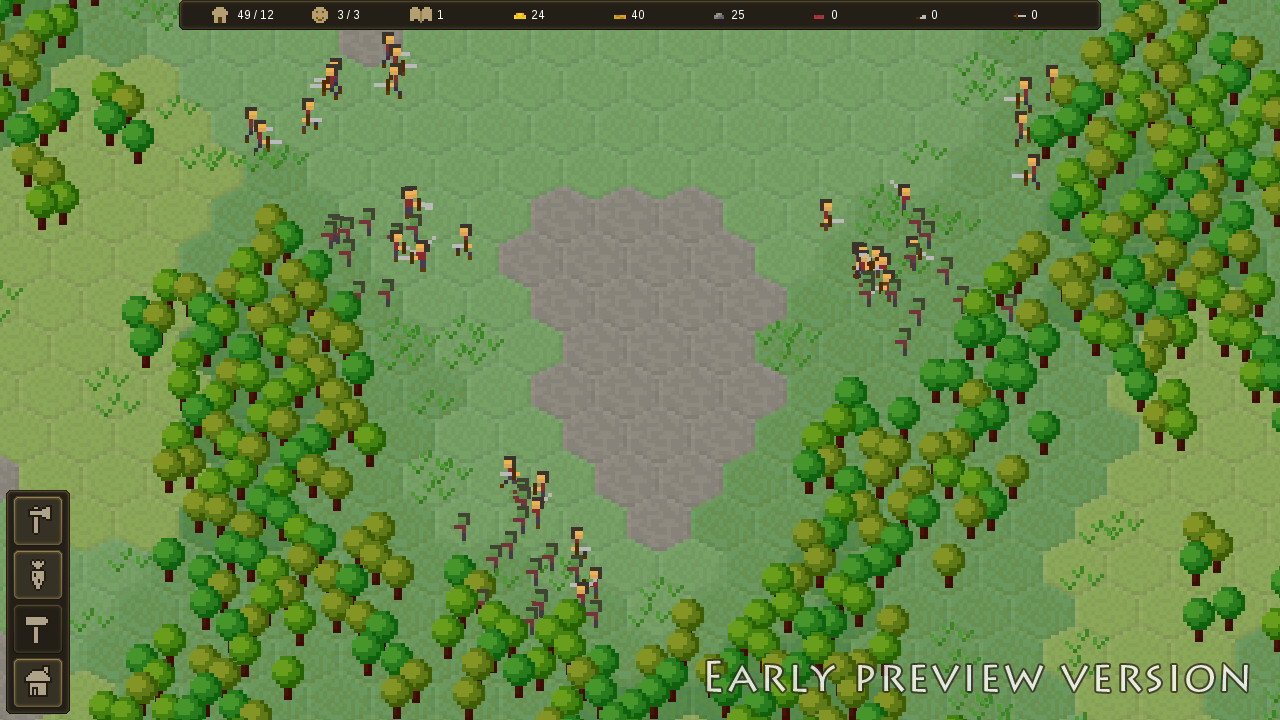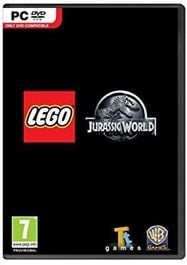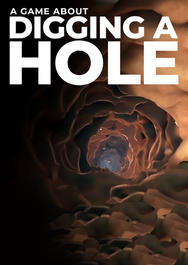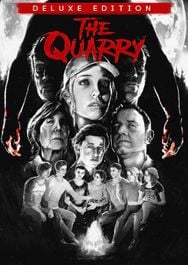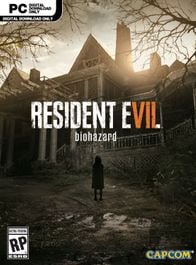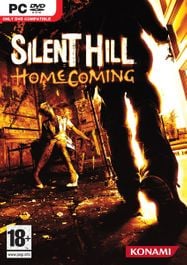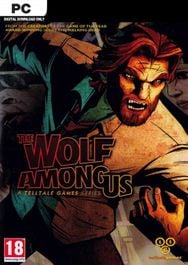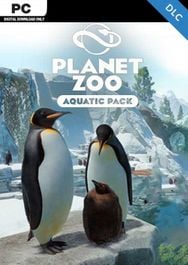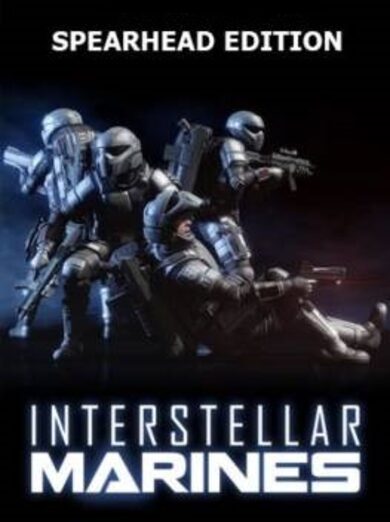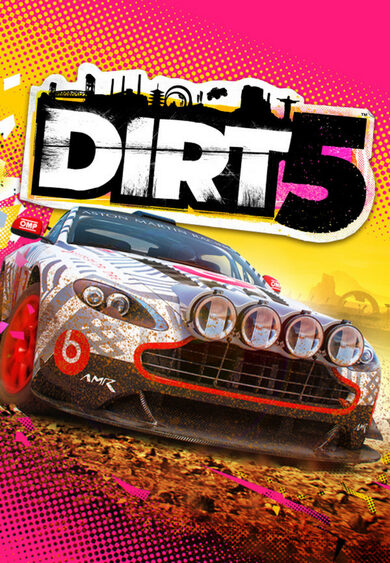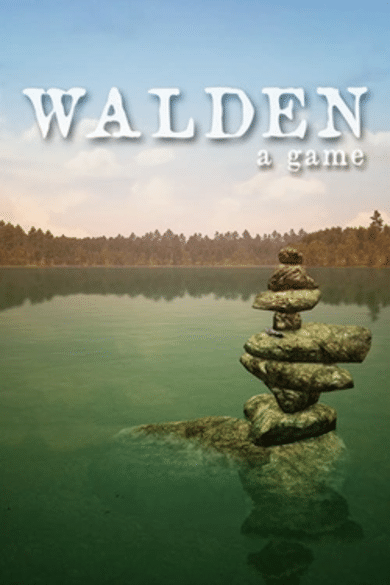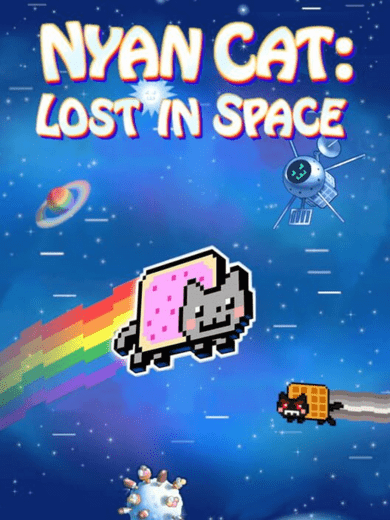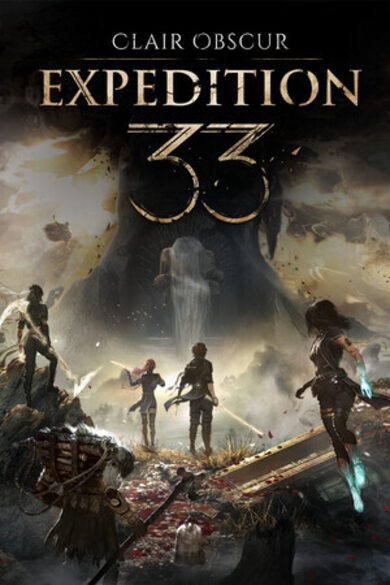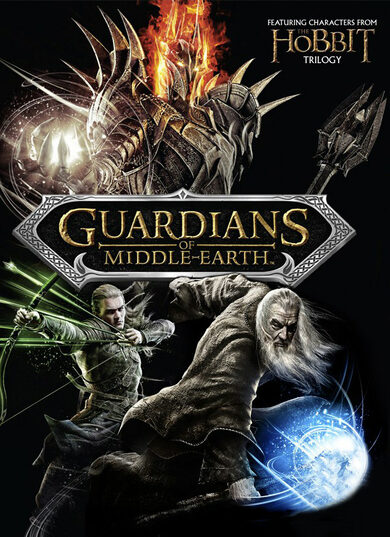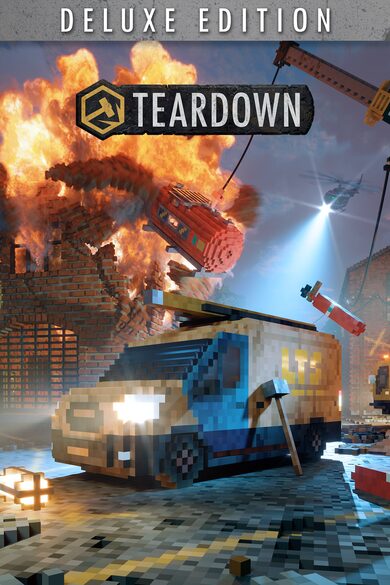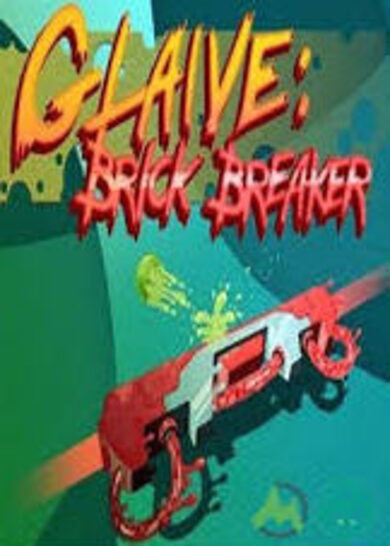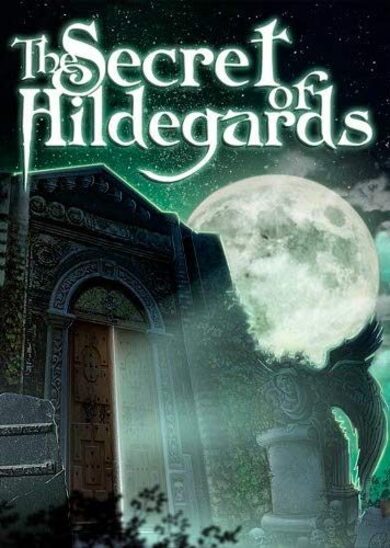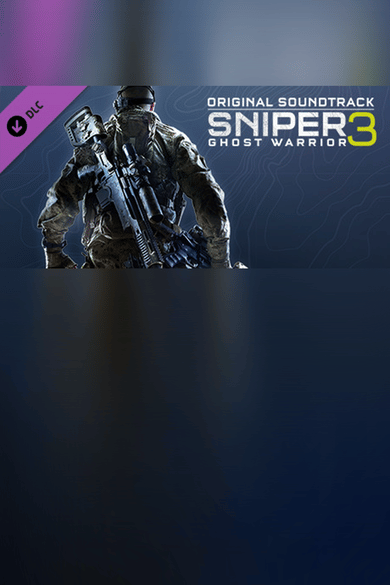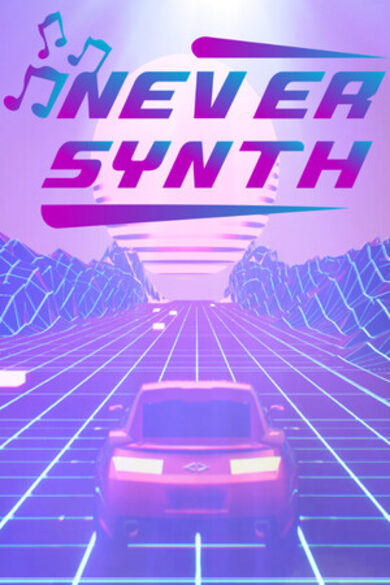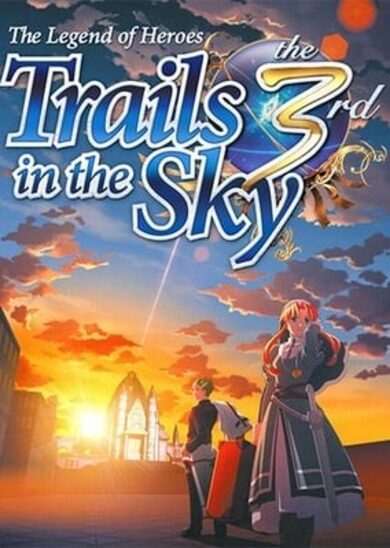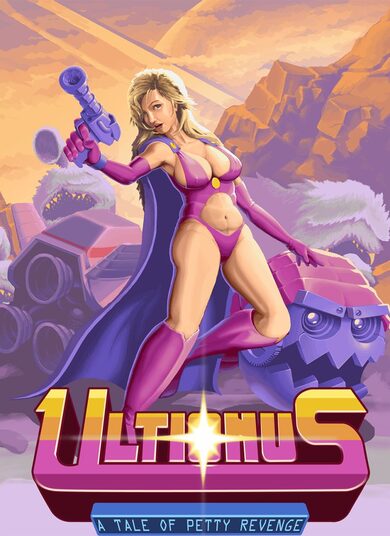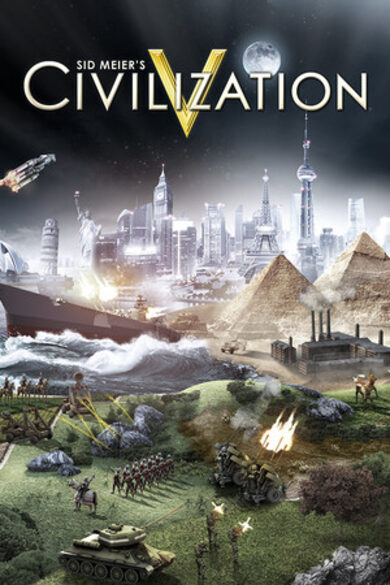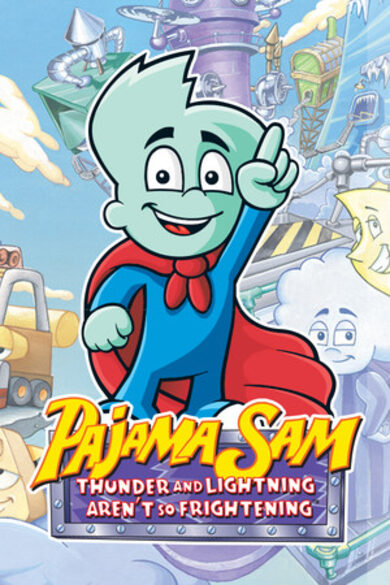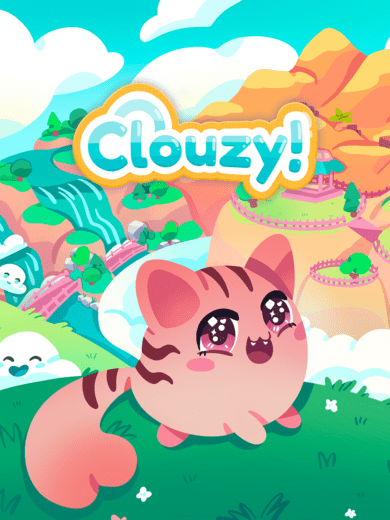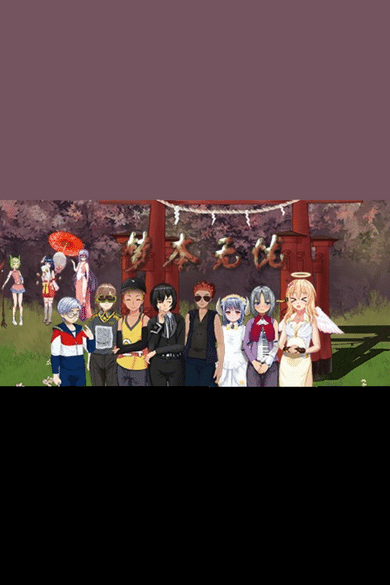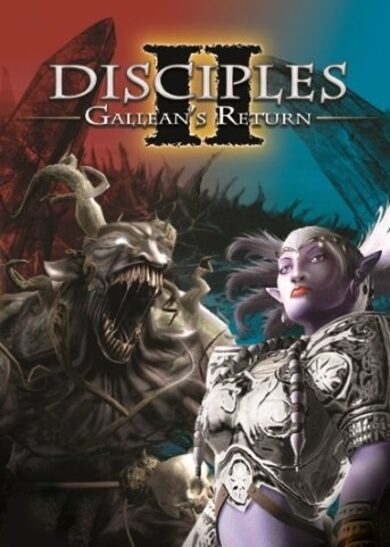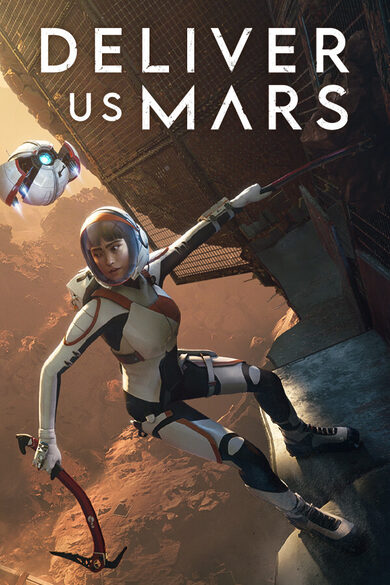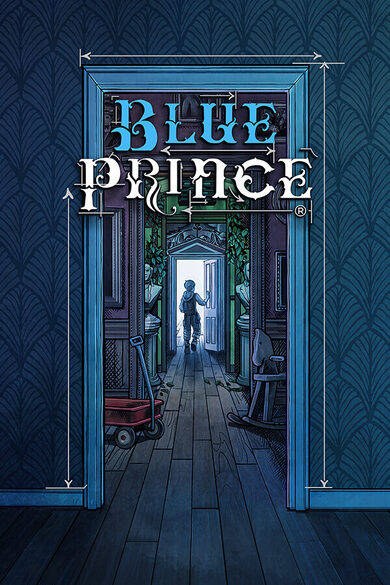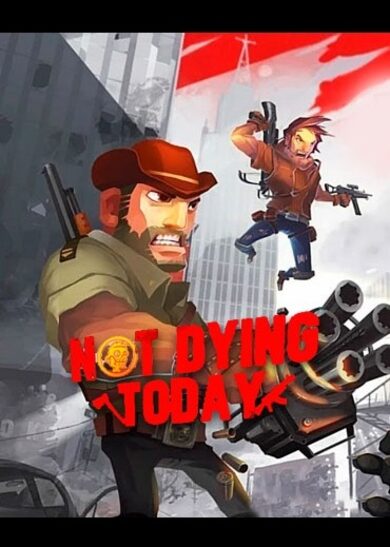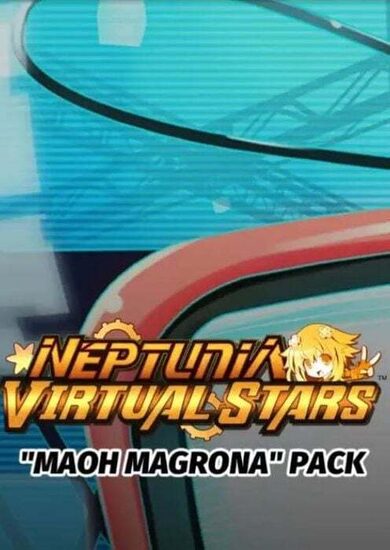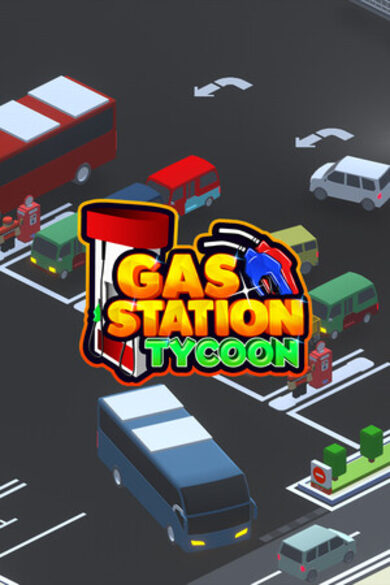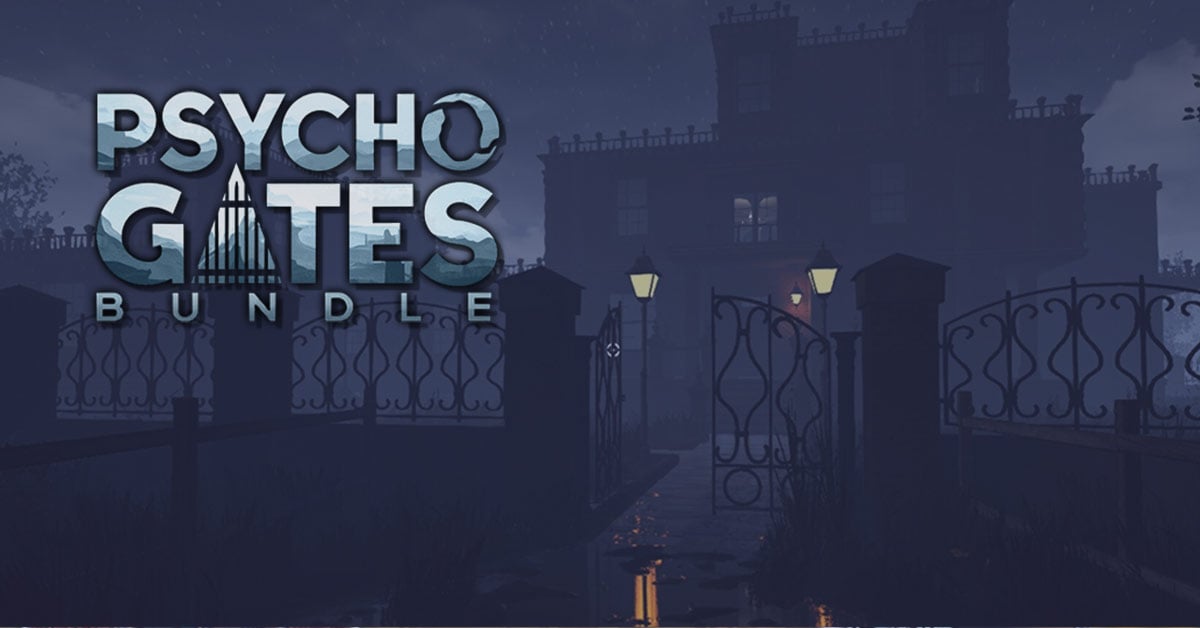
Build and manage your growing town in this relaxing village construction and management simulator with focus on production chains, villager desires and light combat elements.

Start with nothing and grow into a bustling town. Gather and process resources, establish supply and production chains, maintain your villager needs, and defend your settlement.

Collect and record knowledge, research and advance through technologies, and unlock new materials and professions.

Mr. Piggles agrees.

EA Update #17 - Weather
I'll start with the end result of the two effects I implemented, because it's simpler to discuss the steps that way. The two effects are rain:

and snow:

This looks relatively simple, but actually has a lot of internal considerations both from technical and design perspective. I am usually prepared that features end up more complex than they seem to be, but this one really surprised me.
Keeping with pixel art aesthetic, I would want to draw rain droplets and snowflakes. But for performance reason, I cannot draw separate sprites for every particle (this would be many thousands of particles). So I use bigger sprites with multiple droplets that look more or less random:

I call these "slides". The trick is to spawn and overlap, and quickly move many of these slides, so the viewer cannot easily track individual slides and they look like individual droplets.
This seems simple enough... until you try it out and it looks bad. The reason is that the sprite size and the spacing between the particles on the slide is very important. It has to fulfill 2 opposing criteria - it has to be both regular and random. If I make it too big and regular, it will look like a grid moving across the screen. But if I make it too small and random, it will have many unnatural distracting "gaps" and "clumps" of particles. In short, this required a lot of trial and error and even then the result is a compromise.
Individual slides animate by moving downwards and a little to the side:

From there I add a little bit of speed variation to each slide and a corresponding color variation (slower - dimmer, darker). This way, it instantly looks like there are depth layers of particles:

This is probably the biggest visual impact of the whole feature. This variation is fairly subtle in the actual game, otherwise it again becomes too obvious that particles are part of bigger slides.
The depth illusion also really comes together with parallax, which I discuss later.
New slides are spawned above the top of the screen. Then they gradually fall down though their trajectory. Finally, they despawn below the bottom of the screen. Since slides have width and height, then there is an additional margin around the viewport to fit them:

I cannot spawn or despawn slides if they are partially visible; they must have completely left their "visibility area". This means the slides "exist" (simulate, render, animate, etc.) in an area larger than what the camera actually sees. This certainly adds extra complexity and calculations.
Camera zooming changes the number of visible slides:

At first, I began implementing this as simply spawning extra or despawning excess slides at the edges. But I quickly ran into 2 problems.
Firstly, I don't know exactly where to spawn new slides. If I do this randomly, it looks wrong. Weather slides normally gradually fall down though their trajectory. This is theoretically a deterministic process, but practically it just isn't worth the time to re-simulate and predict sprites like that. Plus, I have to (de)spawn them at the "edges" only, which is a lot of additional math to determine the area that does or doesn't need slides.
And secondly, if you zoom in and out quickly, it is very obvious that the weather is not in the same location as before. It might not seem like a big deal, but in practice it's annoyingly way too noticeable.
So what I do instead is I always have a fixed number of slides for the entire most zoomed out view and I simulate them all as if the camera could see them. Of course, I don't render them visually. This might seem like a waste of performance to simulate them, but counter-intuitively at medium zoom, the camera can actually see about 2 out of 3 of the total number of total slides:

So this isn't at all that wasteful and the simple simulation math is fast anyway. Plus, my new rendering logic lets me process this very quickly anyway.
It's a little bit difficult to think about how slides move when the camera is moved/panned. Intuitively, it seems like moving the camera would "move" everything. It's a bit easier to visualize if one thinks about the visible portion of the world changing instead:

From this perspective, the slides form a "box" around the visible world area and this box moves together with the camera viewport. In fact, without animation or parallax it becomes obvious that slides don't actually move at all in respect to the camera:

So there isn't actually anything special that needs to be done for this by itself. Of course, without animation or some movement, it looks completely flat.
Since camera panning is a constant player interaction, then it is very important that this preserves the weather effect depth illusion. I do this with a subtle parallax:

All slides are moved proportionally to the camera pan. Further (dimmer, slower) particles are panned a little bit less than closer (brighter, faster) particles. Thus variable speed, color and movement together form a rather convincing illusion of depth and volume.
So there are 2 ways in which slides can "escape" their box around the world - animation and parallax. Animating slides fall down and right, thus going off the screen. Parallax while panning moves the slides in any of the four directions, also moving them off the screen. Both cases are essentially identical in that theoretically I need to either add or remove slides.
And the solution is actually super simple - I just teleport the slide to the other edge of the camera viewport. For example, if a slide moves too far right, then I teleport it to the left side of the screen across the width of the viewport. Thus, the number of slides remains constant and they preserve the "density" on the screen.

In practice this works like an infinite repeating plane -- no matter how far and fast the slides move, they just wrap around the screen. And this works great.
There is one corner case to this and that's changing resolution (resizing window). This completely messes up all calculations. But I decided to not even bother with this. The visual glitch is not overly horrible and the slides fix themselves eventually. And how often does one change resolutions while playing?
The final feature is to set the mood of the whole scene, which I do by applying a subtle tint to the game world and modifying shadow intensity. It's easiest to visualize by comparing them one after the other in an animation:

Because of color constancy of human vision (and the method I use to blend the colors) it's counterintuitively hard to perceive the change unless you focus on a specific point or the whole image at once. It's more obvious when the game is full screen and the player happens to "unfocus" and notice the difference.
It's more obvious with individual pixels (the eye can pick out warmer and cooler):

What I use for tinting are two "temperature" colors with orange for warm and light blue for cool:

I deliberately only define "cool" and "warm" colors so I can tint the whole scene either one way or the other. While technically I could tint the scene in any mix of colors, multiple colors would end up "fighting" each other and it would be a mess.
Seasons and weather presets define how they affect the world tint and shadows:

Individually, it's basically: summer is warm and winter is cool; sunny sky is warm and rain is cool.
Combining, I get combinations like: sunny summer is hot and snowy winter is cold while cloudy spring is neutral. Moreover, rainy summer or sunny winter is also close to neutral as they "cancel each other out".
Mathematically, this gives me a single "temperature" value between cool and warm, which corresponds to some color between blue and orange. Technically, it's between blue and "nothing" and orange - as the colors reach the neutral midpoint, they "fade" to nothing and there is no tint:

And then I blend this color with everything in the scene. For this, I transform the colors using the soft light overlay blend mode . The exact effect is harder to explain than it is to just show it, but it is basically like shining a weak colored light onto everything, which is essentially what I am going for.
If I were to crank up the tinting to 100% of the tint color, it would look like this:

In contrast to simply multiplying colors, overlay blending methods do not "erase" the underlying color. Meanwhile, color constancy allows the eye to perceive the original colors even when the whole scene is overwhelmed by another color. But even these extreme examples still look relatively reasonable. Which just means that the actual subtle tinting looks very convincing (at least, in my opinion).
A "proper" blending method also keeps color values largely unchanged, which is important in distinguishing elements (for example, tinting doesn't negatively affect people with color blindness):

At first I was going to do more effects like thunder or blizzard. But the problem is that they just become so prominent as to be annoying. So I settled with fewer "gentler" effects for now.
I want to remark that a feature like this is very easy to do badly. And what is "bad" is also highly subjective. It would be much easier to make an easy (fast and dirty) version of effects and shading. But like many video game elements (such as screen shake or full-screen damage effects), it would be very obvious when done badly, with glitches and/or obtrusively. This can make the whole feature very distracting and eventually annoying.
These effects of course have a performance impact. I am drawing large overlapping sprites all over the screen. In fact, before the last rendering revamp update, I couldn't implement these effects without slowing everything down too much.
Both weather effects and tinting can be disabled in the options as well if this is not your thing.
As before, I'm working on housing and civilian needs. I have been working on weather effects in parallel for a while. So I released this update in the meantime just to have an update while I continue with the bulk of the work.
Changes
Add Weather to the game, which includes Cloudy, Sunny, Rain and Snow
Weather gradually transitions between clear, cloudy and precipitating (either rain or snow, depending on the Season)
Rain does not occur at the very start of the world (and older loaded saves)
Add full-screen particle overlay effects during Rain and Snow weather with varied falling animation, parallax and "depth"-based coloring
Weather particles shift and scale based on camera movement and zoom
Add ambient sound during Rain weather
Add HUD current weather icon and tooltip, add weather icons and descriptions
Add world tint "temperature" color based on current weather and season, ranging from cool (blueish tint) to warm (orangish tint), as well as shadow intensity multiplier based on the same criteria
Add audio options toggle for ambient sound (currently, only weather) and volume slider
Add graphics options toggles for weather and world tinting
Add "no habitats in range" issue for Game Warden's Lodges
Custom icons for the Monument techs
Add internal world weather stat tracking
Shift-selecting a building or road to build will also "copy" its construction priority
Animal Habitat selection panel tending label to also show time since last tended
Fixes
Town Hall no longer requires Bricks for construction
Bricklaying tech is no longer required for Town Hall tech
When construction Beehive as auxiliary building, the work range is now shown (with the appropriate label)
Animals (specifically, Fish) spawning on land
Occasional internal error due to lag when playing visual effects
Housing and Firewood goals requiring Market Square and Supply Stall instead of Produce Shop and Supplies Shop respectively
"Wildlife Conservationist" achievement triggering incorrectly
"Balanced Diet" achievement triggering incorrectly due to "Cooked Fish" being required for it, but unobtainable
Deprecated or unimplemented items like "Cooked Fish" appearing in storage selection popup
Optimizations
Full-screen weather effects can affect performance somewhat
Rudy
Snowy Ash Games
In this update, I am adding weather to the game, specifically weather effects for rain and snow. This isn't something that affects gameplay (yet), so it's purely a visual update to make the game look nicer and have some visual variety. And weather is great for this type of goal.
Weather effects
I'll start with the end result of the two effects I implemented, because it's simpler to discuss the steps that way. The two effects are rain:

and snow:

This looks relatively simple, but actually has a lot of internal considerations both from technical and design perspective. I am usually prepared that features end up more complex than they seem to be, but this one really surprised me.
Sprites
Keeping with pixel art aesthetic, I would want to draw rain droplets and snowflakes. But for performance reason, I cannot draw separate sprites for every particle (this would be many thousands of particles). So I use bigger sprites with multiple droplets that look more or less random:

I call these "slides". The trick is to spawn and overlap, and quickly move many of these slides, so the viewer cannot easily track individual slides and they look like individual droplets.
This seems simple enough... until you try it out and it looks bad. The reason is that the sprite size and the spacing between the particles on the slide is very important. It has to fulfill 2 opposing criteria - it has to be both regular and random. If I make it too big and regular, it will look like a grid moving across the screen. But if I make it too small and random, it will have many unnatural distracting "gaps" and "clumps" of particles. In short, this required a lot of trial and error and even then the result is a compromise.
Animating
Individual slides animate by moving downwards and a little to the side:

From there I add a little bit of speed variation to each slide and a corresponding color variation (slower - dimmer, darker). This way, it instantly looks like there are depth layers of particles:

This is probably the biggest visual impact of the whole feature. This variation is fairly subtle in the actual game, otherwise it again becomes too obvious that particles are part of bigger slides.
The depth illusion also really comes together with parallax, which I discuss later.
Margins
New slides are spawned above the top of the screen. Then they gradually fall down though their trajectory. Finally, they despawn below the bottom of the screen. Since slides have width and height, then there is an additional margin around the viewport to fit them:

I cannot spawn or despawn slides if they are partially visible; they must have completely left their "visibility area". This means the slides "exist" (simulate, render, animate, etc.) in an area larger than what the camera actually sees. This certainly adds extra complexity and calculations.
Zooming
Camera zooming changes the number of visible slides:

At first, I began implementing this as simply spawning extra or despawning excess slides at the edges. But I quickly ran into 2 problems.
Firstly, I don't know exactly where to spawn new slides. If I do this randomly, it looks wrong. Weather slides normally gradually fall down though their trajectory. This is theoretically a deterministic process, but practically it just isn't worth the time to re-simulate and predict sprites like that. Plus, I have to (de)spawn them at the "edges" only, which is a lot of additional math to determine the area that does or doesn't need slides.
And secondly, if you zoom in and out quickly, it is very obvious that the weather is not in the same location as before. It might not seem like a big deal, but in practice it's annoyingly way too noticeable.
So what I do instead is I always have a fixed number of slides for the entire most zoomed out view and I simulate them all as if the camera could see them. Of course, I don't render them visually. This might seem like a waste of performance to simulate them, but counter-intuitively at medium zoom, the camera can actually see about 2 out of 3 of the total number of total slides:

So this isn't at all that wasteful and the simple simulation math is fast anyway. Plus, my new rendering logic lets me process this very quickly anyway.
Camera panning
It's a little bit difficult to think about how slides move when the camera is moved/panned. Intuitively, it seems like moving the camera would "move" everything. It's a bit easier to visualize if one thinks about the visible portion of the world changing instead:

From this perspective, the slides form a "box" around the visible world area and this box moves together with the camera viewport. In fact, without animation or parallax it becomes obvious that slides don't actually move at all in respect to the camera:

So there isn't actually anything special that needs to be done for this by itself. Of course, without animation or some movement, it looks completely flat.
Parallax
Since camera panning is a constant player interaction, then it is very important that this preserves the weather effect depth illusion. I do this with a subtle parallax:

All slides are moved proportionally to the camera pan. Further (dimmer, slower) particles are panned a little bit less than closer (brighter, faster) particles. Thus variable speed, color and movement together form a rather convincing illusion of depth and volume.
Boundary
So there are 2 ways in which slides can "escape" their box around the world - animation and parallax. Animating slides fall down and right, thus going off the screen. Parallax while panning moves the slides in any of the four directions, also moving them off the screen. Both cases are essentially identical in that theoretically I need to either add or remove slides.
And the solution is actually super simple - I just teleport the slide to the other edge of the camera viewport. For example, if a slide moves too far right, then I teleport it to the left side of the screen across the width of the viewport. Thus, the number of slides remains constant and they preserve the "density" on the screen.

In practice this works like an infinite repeating plane -- no matter how far and fast the slides move, they just wrap around the screen. And this works great.
Resolution
There is one corner case to this and that's changing resolution (resizing window). This completely messes up all calculations. But I decided to not even bother with this. The visual glitch is not overly horrible and the slides fix themselves eventually. And how often does one change resolutions while playing?
World tint
The final feature is to set the mood of the whole scene, which I do by applying a subtle tint to the game world and modifying shadow intensity. It's easiest to visualize by comparing them one after the other in an animation:

Because of color constancy of human vision (and the method I use to blend the colors) it's counterintuitively hard to perceive the change unless you focus on a specific point or the whole image at once. It's more obvious when the game is full screen and the player happens to "unfocus" and notice the difference.
It's more obvious with individual pixels (the eye can pick out warmer and cooler):

What I use for tinting are two "temperature" colors with orange for warm and light blue for cool:

I deliberately only define "cool" and "warm" colors so I can tint the whole scene either one way or the other. While technically I could tint the scene in any mix of colors, multiple colors would end up "fighting" each other and it would be a mess.
Seasons and weather presets define how they affect the world tint and shadows:

Individually, it's basically: summer is warm and winter is cool; sunny sky is warm and rain is cool.
Combining, I get combinations like: sunny summer is hot and snowy winter is cold while cloudy spring is neutral. Moreover, rainy summer or sunny winter is also close to neutral as they "cancel each other out".
Mathematically, this gives me a single "temperature" value between cool and warm, which corresponds to some color between blue and orange. Technically, it's between blue and "nothing" and orange - as the colors reach the neutral midpoint, they "fade" to nothing and there is no tint:

And then I blend this color with everything in the scene. For this, I transform the colors using the soft light overlay blend mode . The exact effect is harder to explain than it is to just show it, but it is basically like shining a weak colored light onto everything, which is essentially what I am going for.
If I were to crank up the tinting to 100% of the tint color, it would look like this:

In contrast to simply multiplying colors, overlay blending methods do not "erase" the underlying color. Meanwhile, color constancy allows the eye to perceive the original colors even when the whole scene is overwhelmed by another color. But even these extreme examples still look relatively reasonable. Which just means that the actual subtle tinting looks very convincing (at least, in my opinion).
A "proper" blending method also keeps color values largely unchanged, which is important in distinguishing elements (for example, tinting doesn't negatively affect people with color blindness):

Final words
At first I was going to do more effects like thunder or blizzard. But the problem is that they just become so prominent as to be annoying. So I settled with fewer "gentler" effects for now.
I want to remark that a feature like this is very easy to do badly. And what is "bad" is also highly subjective. It would be much easier to make an easy (fast and dirty) version of effects and shading. But like many video game elements (such as screen shake or full-screen damage effects), it would be very obvious when done badly, with glitches and/or obtrusively. This can make the whole feature very distracting and eventually annoying.
These effects of course have a performance impact. I am drawing large overlapping sprites all over the screen. In fact, before the last rendering revamp update, I couldn't implement these effects without slowing everything down too much.
Both weather effects and tinting can be disabled in the options as well if this is not your thing.
Future plans
As before, I'm working on housing and civilian needs. I have been working on weather effects in parallel for a while. So I released this update in the meantime just to have an update while I continue with the bulk of the work.
Full changelog
Changes
Add Weather to the game, which includes Cloudy, Sunny, Rain and Snow
Weather gradually transitions between clear, cloudy and precipitating (either rain or snow, depending on the Season)
Rain does not occur at the very start of the world (and older loaded saves)
Add full-screen particle overlay effects during Rain and Snow weather with varied falling animation, parallax and "depth"-based coloring
Weather particles shift and scale based on camera movement and zoom
Add ambient sound during Rain weather
Add HUD current weather icon and tooltip, add weather icons and descriptions
Add world tint "temperature" color based on current weather and season, ranging from cool (blueish tint) to warm (orangish tint), as well as shadow intensity multiplier based on the same criteria
Add audio options toggle for ambient sound (currently, only weather) and volume slider
Add graphics options toggles for weather and world tinting
Add "no habitats in range" issue for Game Warden's Lodges
Custom icons for the Monument techs
Add internal world weather stat tracking
Shift-selecting a building or road to build will also "copy" its construction priority
Animal Habitat selection panel tending label to also show time since last tended
Fixes
Town Hall no longer requires Bricks for construction
Bricklaying tech is no longer required for Town Hall tech
When construction Beehive as auxiliary building, the work range is now shown (with the appropriate label)
Animals (specifically, Fish) spawning on land
Occasional internal error due to lag when playing visual effects
Housing and Firewood goals requiring Market Square and Supply Stall instead of Produce Shop and Supplies Shop respectively
"Wildlife Conservationist" achievement triggering incorrectly
"Balanced Diet" achievement triggering incorrectly due to "Cooked Fish" being required for it, but unobtainable
Deprecated or unimplemented items like "Cooked Fish" appearing in storage selection popup
Optimizations
Full-screen weather effects can affect performance somewhat
Rudy
Snowy Ash Games
[ 2022-02-14 16:37:42 CET ] [Original Post]
Minimum Setup
- OS: Ubuntu 16.04+
- Processor: SSE2+ supportMemory: 1 GB RAM
- Memory: 1 GB RAM
- Graphics: 1280x720+. shader model 4.0+
- Storage: 500 MB available space
GAMEBILLET
[ 6357 ]
FANATICAL
[ 6590 ]
GAMERSGATE
[ 3177 ]
MacGameStore
[ 2532 ]
INDIEGALA
[ 1655 ]
LOADED
[ 1040 ]
ENEBA
[ 32822 ]
Green Man Gaming Deals
[ 867 ]
AllKeyShop
[ 45625 ]
YUPLAY
[ 6040 ]
Gamivo
[ 17227 ]
HUMBLE
[ 819 ]
FANATICAL BUNDLES
GMG BUNDLES
HUMBLE BUNDLES
INDIEGALA BUNDLES
by buying games/dlcs from affiliate links you are supporting tuxDB

